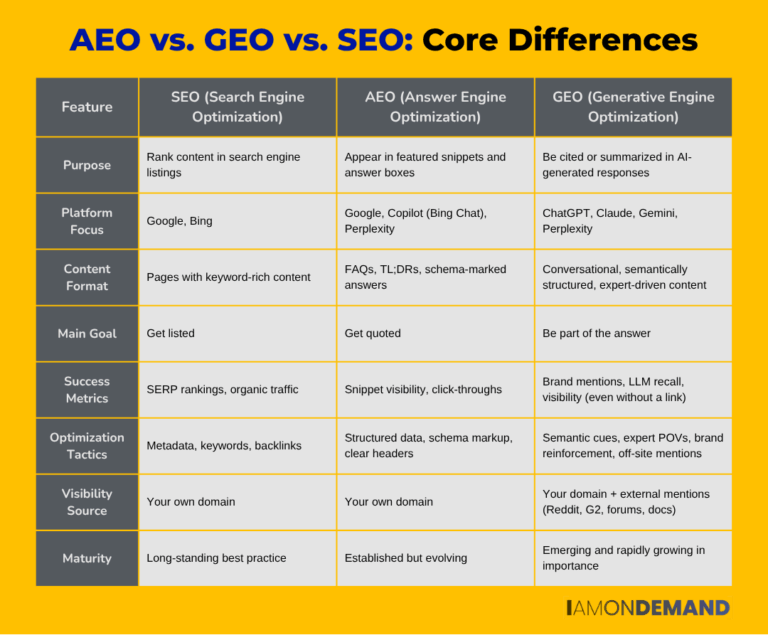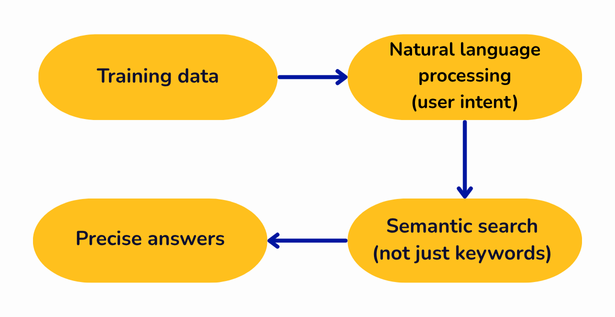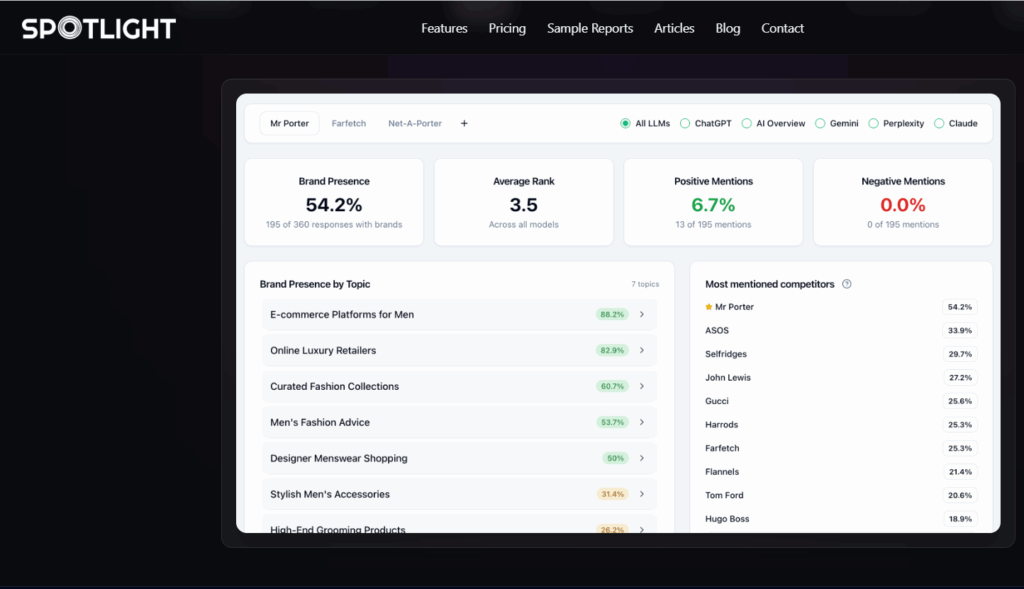Key Insights
- GEO and AEO are essential for AI-era discoverability. Generative engine optimization (GEO) and answer engine optimization (AEO) are now critical for getting your content discovered and cited in AI-powered answers. These strategies complement (not replace) traditional SEO. All three must work together.
- LLMs reward clear, expert-driven content. Large language models (LLMs) like ChatGPT and Google Gemini, as well as AI-generated search overviews, prioritize well-structured, semantically rich content from recognized subject-matter experts—especially when it provides precise, actionable answers.
- Attribution is about more than backlinks. Authorship by real experts and logical structure help AI engines recognize and use your content, boosting brand recall even when there’s no direct link.
- Success requires ongoing auditing. Marketers need to regularly audit how AI presents their brand and update content based on what’s actually being cited and summarized. Omnipresence across multiple sources (not just your website) is crucial.
This guide is your GEO playbook. Below, I’ll break down the core principles of GEO, introduce the types of content that perform best in the AI era, and share a comprehensive checklist for making your content AI-friendly—plus strategies for optimizing what you already have.
How to Optimize Your Tech Content for Generative Engine Optimization and Answer Engine Optimization
If your content isn’t showing up in tools like ChatGPT, Perplexity, or Gemini, your audience may never see it—no matter how well it ranks on Google. Generative engine optimization (GEO) as well as optimizing content for AI-generated answers (AEO) are now essential for any modern content strategy.
Search is no longer the default for many users. It’s being replaced—quietly but rapidly—by conversational AI engines that summarize, compare, and recommend brands directly in the interface. And those engines don’t just pull from blog posts. They analyze product docs, Reddit threads, customer reviews, and structured data across the web.
If you want your B2B tech content to be discoverable in this new landscape, GEO needs to become part of your publishing DNA.
At IOD, we work with cloud, DevOps, cybersecurity, data, and AI brands to optimize not just for clicks—but for inclusion in AI-generated answers. We’ve seen firsthand how structuring content differently, using SME-driven frameworks, and reinforcing brand mentions can significantly boost AI-era content visibility in tools like ChatGPT and Claude.
In this post, we’ll break down:
- What GEO and AEO actually are, and how they differ from traditional SEO
- How large language models (LLMs) source, interpret, and present B2B content
- Proven tactics to improve AI content discoverability and brand recall
- How to audit your existing content for GEO readiness
- What success looks like in the age of AI-powered content delivery
This is your guide to making sure your tech marketing content isn’t just indexed—but included in the conversation.
What Is GEO and How Is It Different from Traditional SEO?
GEO is a set of strategies for making your content the primary source for generative AI models, like those used in chatbots and large language models (LLMs). It’s another layer of B2B content discoverability on top of traditional SEO.
How Is GEO Different from Traditional SEO?
Traditional SEO focuses on getting a website to rank high in a list of links on a search engine results page. GEO, on the other hand, optimizes content to be summarized in an AI-generated answer. It prioritizes clarity, structure, and attribution over simple keywords.
How Does GEO Work?
GEO goes beyond your website. It means optimizing your presence everywhere your audience and AI engines look for information:
- Site pages
- Blog posts
- User forums (like Reddit, Stack Overflow)
- Other community or third-party platforms where relevant questions and discussions happen
It’s not SEO vs. GEO: Traditional SEO and GEO work together as part of a holistic content strategy. Let’s explore some of the ways you can achieve that.
What Is AEO, and How Does It Differ from GEO and SEO?
Answer engine optimization (AEO) specifically targets snippet-style direct answers in traditional search.
- AEO helps you show up in search engine answer boxes.
- GEO helps you show up in AI-generated answers.
- SEO helps you get ranked in search engine listings.
You need all three. But GEO is the newer, often overlooked layer that’s becoming essential as users shift from traditional search to LLM-powered discovery via tools like ChatGPT, Claude, and Gemini.

Think of it this way:
- SEO was built to help you rank.
- AEO evolved to help you get quoted.
- GEO ensures your brand is referenced and included in AI-generated conversations, even when no direct links are present.
AEO vs. GEO vs. SEO: Core Differences

Key Takeaway
GEO builds on AEO and adapts it for a new content reality: one where LLMs—not just search engines, are how people discover, evaluate, and engage with information.
How Do LLMs Find and Surface B2B Tech Content?
LLMs find B2B tech content by learning industry language from vast training datasets including articles, white papers, and reports. After using natural language processing to understand user intent, they use semantic search to surface relevant information, then quickly summarize and synthesize this information, going beyond keywords to deliver precise answers.

That means LLMs don’t just read your blog; they scan the entire web for signals of authority, clarity, and usefulness. To show up in AI answers, you need to focus on how you structure your content as well as what you say.
What Kind of Content Do LLMs Prioritize?
LLMs prioritize content created around guidelines like Google’s E-E-A-T (Experience, Expertise, Authoritativeness, and Trustworthiness) framework. Although E-E-A-T was originally created for human raters, it can also help you understand how LLMs find and use content.
Google experts also suggest that considering the “Who, How, and Why” of content creation will help with SEO, and that will help LLMs prioritize your content as well.
For hands-on tips, see our guide to mastering prompt design for tech marketers.
Where Do LLMs Get Their Information?
LLMs get information from a wide mix of sources, including well-structured blog posts and documentation on tech brand websites, mentions in industry listicles, YouTube, LinkedIn, product reviews on sites like G2 and Capterra, and user-generated content, like Reddit threads, Stack Overflow, and similar sites.
LLMs spot fluff easily and will skip pages littered with filler, like meaningless or generic content.
To attract an LLM’s interest, you need useful, human-led content with a strong human voice and technical insights from subject matter experts (SMEs). Ideally, these will be practitioner-level personas who have hands-on experience with the technology you’re writing about, like DevOps team leads and cloud security architects.
Top 3 Tips for Getting Your Content Prioritized by LLMs
- Clear structure: This includes Q&A formats, subheadings, and takeaway boxes or TL;DRs. An arXiv study found that clear structure increased content’s likelihood of appearing in AI-generated responses by 37%. This is the “how” of content creation—making your ideas transparent and understandable.
- Semantic clarity: LLMs prefer content with logically grouped concepts and human-readable phrasing. This is the “why” of content creation, i.e., what value does your content add to the topic?
- Domain authority: LLMs prioritize content from recognized experts and trusted organizations. This is the “who” of content creation that will also give you an SEO boost.
How fresh your content is also matters. Newer or recently updated content often takes priority. You can improve GEO by refreshing older pages and posts regularly, as we’ll explain.
What Does GEO-Friendly Tech Marketing Content Look Like?
GEO-friendly tech marketing content provides clear, conversational answers to user queries, using semantically related terms. These answers are provided in clean, scannable formats with immediate takeaways and structured data—delivered in a confident, human expert tone. (See AWS prompt engineering 101 for an example of practical creation for GenAI engines.)
At IOD, our GenAI-driven content workflows embed subject-matter experts in cloud, DevOps, cybersecurity, data, and AI at every stage: from strategy and ideation through content creation and optimization. Together with our team of strategists, editors, and marketing professionals, we ensure every content asset (blog post, white paper, video, and more) is accurate, discoverable, and credible from the start.
Do Keywords Still Matter When Creating GEO-Friendly Content?
Yes, keywords still matter when you’re creating GEO-friendly content, but not in the way traditional SEO taught us.
In GEO, influence often matters more than authorship. That makes it distinctly different from traditional SEO. In fact, a 2025 Semrush study showed that LLMs tend to cite pages that rank lower in traditional search. ChatGPT, for example, surfaced pages that ranked in search positions 21+ (very low). Perplexity and Google showed similar results.
That means that even without top SEO, LLM attribution could become a big driver of revenue and traffic.
Instead of exact-match phrases, GEO-friendly content mirrors the way real people ask and answer questions. It’s about structuring your content in a way that’s easy for large language models (LLMs) to understand, summarize, and reuse.
Think: Questions, Clarity, and Context.
Top 3 Tips for Creating GEO-Friendly Content:
- Human-centric keywords & semantic web: Focus on how real people use keywords within your industry. Craft articles using semantically related terms to build a rich “semantic web” around a topic, rather than simply repeating a single keyword. This helps LLMs grasp deeper context.
- Conversational, Q&A structure: Structure your content to provide clear, direct, and conversational answers to full questions. Favor formats such as how-to guides, product comparisons, and FAQs, which align with AI’s generative capabilities.
- Start with the answer: Ensure your opening paragraph or main headings (H1/H2) immediately resolve the user’s core question. This allows LLMs to quickly extract and surface the most relevant information.
For more tips, be sure to scan our checklist for GEO-ready content below.
How Can You Increase Attribution in LLM Responses?
You can increase attribution, meaning your brand’s insights are recognized and used by an LLM (even if there’s no direct link), by making your content recognizable, trustworthy, and easy for LLMs to process—through consistent branding, unique insights, and clear structure.
When an LLM uses your insights, even without a direct link, it boosts credibility and brand recall, potentially leading to future direct searches and conversions.
Top 3 LLM-Ready Best Practices for Higher Attribution
- Credible authorship: Use SME bylines and bios to clearly highlight expert authors. Maintaining a consistent, natural brand voice helps establish your authority.
- Unique value: Publish original research, distinct product points of view (POVs), and proprietary frameworks. This demonstrates unique expertise, which LLMs value for generating insights.
- Brand reinforcement: Naturally and consistently reference your company/product name within the content. This helps LLMs directly associate your brand with specific knowledge.
For more tips, be sure to scan our full checklist for GEO-ready content below.
By combining these strategies, your brand is more likely to be recognized and cited by AI engines, increasing content visibility in AI chatbots and your brand’s influence.
How Can You Audit and Improve Existing Content for GEO?
To audit and improve for GEO, start by identifying how LLMs currently present your brand. Auditing has rapidly evolved from manual checks to a tool-powered discipline, thanks to a growing ecosystem of LLM visibility platforms. These include specialized tools like Profound, Peec.ai, Spotlight, AthenaHQ, and Limy, as well as established SEO platforms like Semrush and seoClarity with GEO features.
These tools are designed to track where your brand appears in AI-generated answers, and many now provide frequency and context details as well. Some even generate content briefs based on your visibility gaps.
By identifying visibility gaps, producing targeted content, and regularly rechecking these tools to measure results, you can continually optimize your strategy—and significantly increase your brand’s presence and authority in AI-generated answers.

At IOD, performance is at the heart of our content marketing process. We leverage LLM visibility data to spot gaps and opportunities; produce targeted, expert-led content to address them; and then continuously monitor results—refining strategy based on real-world performance. This cycle ensures your content is always optimized for discoverability, credibility, and measurable impact both in traditional search and in AI-generated answers.
4 Crucial Steps to Audit and Improve GEO Performance
- Establish your baseline: Use LLM visibility tools to see how your brand currently appears in AI-generated answers on platforms like ChatGPT, Gemini, Claude, and Perplexity. Note the factual accuracy, tone, and prominence of your mentions.
- Reformat for AI comprehension: Update your most important blog posts and product pages using Q&A formats, concise subheadings, and TL;DR or “quick takeaways” boxes. Make content easy for both users and LLMs to parse and summarize. (See our GEO checklist below for more formatting tips.)
- Enhance with value and authority: Add fresh use cases, product names, unique insights, and competitive comparisons. Strengthen your domain authority with internal links to technical blogs and cornerstone content.
- Continuously monitor and optimize: Recheck your LLM visibility every few months to track how updates impact brand presence and attribution. Refine your strategy based on results and regularly refresh content to maintain visibility as LLMs and AI answers evolve.
How Do You Measure GEO Success for Tech Brands?
GEO success isn’t about traditional website traffic alone. Instead, it’s measured by how often your ideas and expertise are surfaced, cited, or summarized by LLMs and AI-powered tools.
4 Signs Your GEO Strategy Is Working
- Your brand or product name appears in LLM-generated answers to relevant prompts.
- You see referral traffic from AI tools and sources.
- AI-generated posts or summaries reference your frameworks, blog sections, or original research.
- You notice increased impressions in Google Search Console (GSC)—often tied to AI Overview exposure—even without changes in your regular search rankings.
A true marker of GEO maturity: Your content becomes a trusted source of truth, cited both externally (by AI tools) and internally (by your own teams).
✓Checklist for GEO-Ready Content
Content Design & Presentation
Technical Foundation & Authority
Distribution & Performance Strategy
TL;DR
We’ve boiled everything down for you into this one-minute guide to creating content that’s as GEO-friendly as possible:
- Does the opening paragraph clearly answer a key product or user question?
- Are subheadings written like buyer or user queries?
- Have you kept paragraphs short and used bullet points for clarity (in moderation)?
- Is there a TL;DR, “quick takeaways” section, or executive summary?
- Is the author/brand clearly attributed as a source?
- Have you tested the content with ChatGPT, Gemini, or Perplexity?
Top tip
Make sure your content is lightweight and clean. Use minimal JavaScript, and include structured data (like FAQs and reviews) to help AI tools easily understand and index your pages.
Create GEO Content That Delivers Measurable Performance
There are no shortcuts to lasting GEO results. Just as keyword stuffing failed in early SEO, chasing LLM “hacks” isn’t a strategy. Performance in the GenAI era means producing content that is both technically accurate and immediately visible to LLMs, while minimizing cost and bottlenecks.
At IOD, we don’t just produce B2B tech content—we engineer for performance from the ground up.
Our process fuses GenAI-driven speed with deep practitioner expertise, all anchored by LLM visibility analytics. This ensures every asset you create is purposeful, measurable, and designed to win both with AI and real buyers.
The IOD Performance-Driven Content Engine
- GenAI at scale, experts at the core: We blend machine speed with human expertise. Senior tech practitioners as well as technical editors and creatives collaborate from the start, so every piece is reliable, relevant, and grounded in real experience.
- LLM visibility is the new performance metric: True content ROI isn’t just traffic. It’s how fast your brand appears in AI answers, and how much you save on production and review. Using LLM visibility tools, we track which articles, frameworks, and messages are being cited, so your optimizations are data-driven, not guesswork.
- Automated, programmatic context: IOD’s system isn’t just a stack of disconnected tools or chatbots. We use a programmatic approach (rooted in your brand DNA, ICPs, product docs, and market context) to ensure every article is both relevant and reusable. Targeted human review reduces cost and speeds up approvals.
- Continuous optimization, not one-offs: We don’t just publish and hope. Every few months, we monitor LLM visibility and measure what’s working—then update, iterate, and improve. This cycle lets your content keep pace with changing AI models, market shifts, and business goals.
Ready to see what a practitioner-built, GenAI-powered, performance-driven engine can do for your visibility and GTM?
FAQ
Is traditional SEO still important if I’m focusing on GEO and AEO?
Yes! Traditional SEO, GEO, and AEO work together as part of a complete content strategy. You need all three to maximize discoverability across search engines and AI-powered tools.
What’s the best way for a beginner to start optimizing content for GEO?
Start by checking how your brand appears in LLMs like ChatGPT and Gemini. Then, create clear, Q&A-style content that answers real user questions, shows your expertise, and is easy to scan.
How can I track the success of my GEO efforts?
Check how your brand and products appear in responses from LLMs like ChatGPT, Gemini, and Perplexity. Specialized tools (like Profound, Peec.ai, and Spotlight) offer visibility metrics to help monitor and improve your results.
Do I need a large team or specialized tools to implement GEO effectively?
You don’t need a large team to implement GEO effectively. Most GEO strategies work with a lean content marketing team. But to measure and improve your results, you’ll want an LLM visibility tool such as Profound, Peec.ai, Spotlight, AthenaHQ, or a traditional SEO tool with GEO features like Semrush.
How often should I update my content to stay GEO-friendly?
Plan to review and refresh your key content every few months. LLMs prioritize fresh, accurate information, so regular updates keep your brand visible as AI engines and algorithms evolve.

